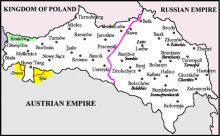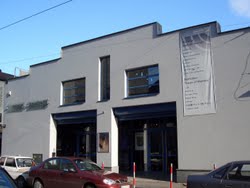Jews of Galicia
 Galicia, as an administrative and geographical term is usually connected with the period of partition of Poland and brings to mind the territories of Podole and Wolyn taken by Austria in 1772. Nevertheless the political history of this land, called formerly Red Russia dates back to XII century. The name itself according to one of the theories may derive from the period of migration of peoples. The names Galics in the British Isles, Gallatia in the Balcans, Gallia or Gaul in France, Galicia in Spain and Galicja in Poland and todays Ukraine are testimonies of the route taken by the Goidels or Gaidheil tribes, in their migration into Europe from a place somewhere in Asia Minor. According to another theory the name Galicia (ukr. Halychyna) derives from Halicz (ukr. Halych), town which in 1140 became the seat of the first prince of Galicia, called Vladimir. The Name Halicz itself derives from Ukrainian word "halka" meaning "crow" in English. That is why there is a crow on the coat of arms of this land. At the turn of the XII and XIII century the territories of Galicia were possessed by Polish, Hungarian and Volynian princes and in 1223 they faced the first Tartar and Mongolian invasion. The period of the greatest glory for the duchy of Galicia started when prince Daniel, the descendant of Volynian princes took his office in 1238. Daniel fought off the Tartar invasions, managed to break the Polish - Hungarian alliance and captured Kiev. In 1250 prince Daniel in memory of his son Lew founded a new city of Lviv, which soon became a capital. Three years later Daniel was crowned by Papal Delegate, however already in 1264 he died and Galicia fell into decline.
Galicia, as an administrative and geographical term is usually connected with the period of partition of Poland and brings to mind the territories of Podole and Wolyn taken by Austria in 1772. Nevertheless the political history of this land, called formerly Red Russia dates back to XII century. The name itself according to one of the theories may derive from the period of migration of peoples. The names Galics in the British Isles, Gallatia in the Balcans, Gallia or Gaul in France, Galicia in Spain and Galicja in Poland and todays Ukraine are testimonies of the route taken by the Goidels or Gaidheil tribes, in their migration into Europe from a place somewhere in Asia Minor. According to another theory the name Galicia (ukr. Halychyna) derives from Halicz (ukr. Halych), town which in 1140 became the seat of the first prince of Galicia, called Vladimir. The Name Halicz itself derives from Ukrainian word "halka" meaning "crow" in English. That is why there is a crow on the coat of arms of this land. At the turn of the XII and XIII century the territories of Galicia were possessed by Polish, Hungarian and Volynian princes and in 1223 they faced the first Tartar and Mongolian invasion. The period of the greatest glory for the duchy of Galicia started when prince Daniel, the descendant of Volynian princes took his office in 1238. Daniel fought off the Tartar invasions, managed to break the Polish - Hungarian alliance and captured Kiev. In 1250 prince Daniel in memory of his son Lew founded a new city of Lviv, which soon became a capital. Three years later Daniel was crowned by Papal Delegate, however already in 1264 he died and Galicia fell into decline.

In 1349 Polish king Kazimierz the Great, seated in Cracow, seized the Red Russia and a part of Wolyn and in this way he enlarged the boundaries of Poland for the Galicia territory. This land remained under Polish King's rule up until 1772. In 1648 Bogdan Chmielnicki became the leader of Cossack/Kozak uprising against Polish authorities. This revolt was responsible for numerous pogroms of Polish Jews . Long term civil war devastated Galicia, leading whole region to an economic stagnation. On the 5th of August 1772 Austria seized the eastern Galicia, taking part in the partition of Poland with Prussia and Russia. Next partitions and the gradual limitations of Galicean autonomy led in 1795 to the Austrian capture of Cracow. During Austrian times, Galicia extended from the Biala River (minor tributary of the Vistula) in the west to the Zbrucz/Zbruch, (tributary of the Dniester in the east). From the Carpathians in the south, to the land drops off to the north, passing over the Sarmatian Plain. At its largest during Austrian period, Galicia comprised approximately 78, 000 square kilometers. Two main cities Cracow and Lviv soon became very resilient academic and political centers of partitioned Poland. Under the rule of emperor Franz Josef broad autonomy was granted to Galicia due to the political shrewdness and common sense of Polish intelligentsia.
You might also like








 The Galicia Jewish Museum (Polish: Żydowskie Muzeum Galicja) is located in the historical Jewish district Kazimierz in Kraków, Poland. It focuses on the traces of Jewish life and culture that can still be found in the area of the historic Austro-Hungarian province of Galicia located in modern Poland.
The Galicia Jewish Museum (Polish: Żydowskie Muzeum Galicja) is located in the historical Jewish district Kazimierz in Kraków, Poland. It focuses on the traces of Jewish life and culture that can still be found in the area of the historic Austro-Hungarian province of Galicia located in modern Poland.